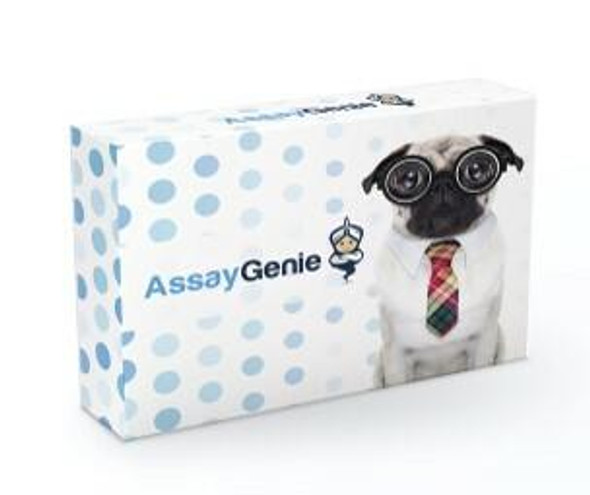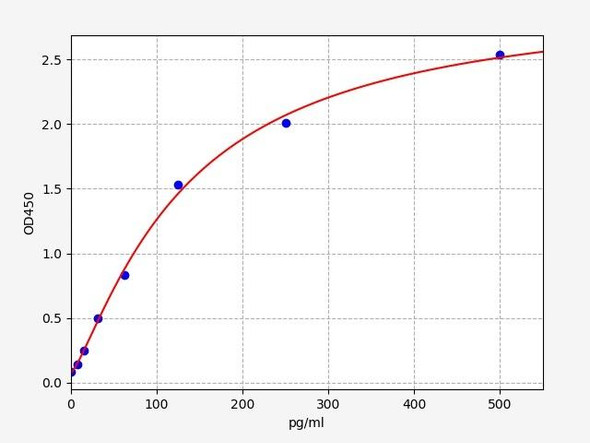Description
Rat GM-CSF ELISA Kit
The Rat GM-CSF (Granulocyte-Macrophage Colony-Stimulating Factor) ELISA Kit is a highly specific and sensitive assay designed for the quantitative measurement of GM-CSF levels in rat serum, plasma, and tissue homogenates. This kit provides accurate and reproducible results, making it an excellent tool for researchers studying the role of GM-CSF in immune responses, inflammation, and hematopoiesis.GM-CSF is a key cytokine that regulates the production and function of granulocytes and macrophages, playing a crucial role in immune system modulation and host defense.
Abnormal levels of GM-CSF have been implicated in various diseases such as autoimmune disorders, inflammatory conditions, and cancer, making it a valuable biomarker for monitoring disease progression and evaluating therapeutic interventions.With its superior performance characteristics and ease of use, the Rat GM-CSF ELISA Kit is an essential tool for investigating the physiological and pathological functions of GM-CSF in rat models, advancing our understanding of immune regulation and disease processes.
| Product Name: | Rat GM-CSF ELISA Kit |
| Product Code: | RTFI00020 |
| Size: | 96 Assays |
| Target: | Rat GM-CSF |
| Alias: | GM-CSF, Granulocyte Macrophage Colony Stimulating Factor, GMCSF, CSF2 |
| Reactivity: | Rat |
| Detection Method: | Sandwich ELISA, Double Antibody |
| Sensitivity: | 9.375pg/ml |
| Range: | 15.625-1000pg/ml |
| Storage: | 4°C for 6 months |
| Note: | For Research Use Only |
| Recovery: | Matrices listed below were spiked with certain level of Rat GM-CSF and the recovery rates were calculated by comparing the measured value to the expected amount of Rat GM-CSF in samples. | ||||||||||||||||
| |||||||||||||||||
| Linearity: | The linearity of the kit was assayed by testing samples spiked with appropriate concentration of Rat GM-CSF and their serial dilutions. The results were demonstrated by the percentage of calculated concentration to the expected. | ||||||||||||||||
| |||||||||||||||||
| Intra-Assay: | CV <8% | ||||||||||||||||
| Inter-Assay: | CV <10% |
| Uniprot: | P48750 |
| UniProt Protein Function: | GMCSF: Cytokine that stimulates the growth and differentiation of hematopoietic precursor cells from various lineages, including granulocytes, macrophages, eosinophils and erythrocytes. Belongs to the GM-CSF family. |
| UniProt Protein Details: | Protein type:Secreted; Cytokine; Secreted, signal peptide Cellular Component: extracellular space Molecular Function:growth factor activity; granulocyte macrophage colony-stimulating factor receptor binding; cytokine activity Biological Process: negative regulation of cytolysis; epithelial fluid transport; embryonic placenta development; positive regulation of interleukin-23 production; myeloid dendritic cell differentiation; regulation of cell proliferation; epithelial cell proliferation; macrophage activation; positive regulation of tyrosine phosphorylation of Stat5 protein; regulation of gene expression; positive regulation of cell proliferation; immune response; positive regulation of macrophage differentiation; positive regulation of DNA replication |
| NCBI Summary: | plays a role in alveolar epithelial fluid transport [RGD, Feb 2006] |
| UniProt Code: | P48750 |
| NCBI GenInfo Identifier: | 215273996 |
| NCBI Gene ID: | 116630 |
| NCBI Accession: | P48750.2 |
| UniProt Related Accession: | P48750 |
| Molecular Weight: | 16,562 Da |
| NCBI Full Name: | Granulocyte-macrophage colony-stimulating factor |
| NCBI Synonym Full Names: | colony stimulating factor 2 (granulocyte-macrophage) |
| NCBI Official Symbol: | Csf2 |
| NCBI Official Synonym Symbols: | Gmcsf; Gm-csf |
| NCBI Protein Information: | granulocyte-macrophage colony-stimulating factor; CSF |
| UniProt Protein Name: | Granulocyte-macrophage colony-stimulating factor |
| UniProt Synonym Protein Names: | Colony-stimulating factor; CSF |
| Protein Family: | Granulocyte-macrophage colony-stimulating factor |
| UniProt Gene Name: | Csf2 |
| UniProt Entry Name: | CSF2_RAT |
| Step | Procedure |
| 1. | Set standard, test sample and control (zero) wells on the pre-coated plate respectively, and then, record their positions. It is recommended to measure each standard and sample in duplicate. Wash plate 2 times before adding standard, sample and control (zero) wells! |
| 2. | Aliquot 0.1ml standard solutions into the standard wells. |
| 3. | Add 0.1 ml of Sample / Standard dilution buffer into the control (zero) well. |
| 4. | Add 0.1 ml of properly diluted sample ( Human serum, plasma, tissue homogenates and other biological fluids.) into test sample wells. |
| 5. | Seal the plate with a cover and incubate at 37°C for 90 min. |
| 6. | Remove the cover and discard the plate content, clap the plate on the absorbent filter papers or other absorbent material. Do NOT let the wells completely dry at any time. Wash plate X2. |
| 7. | Add 0.1 ml of Biotin- detection antibody working solution into the above wells (standard, test sample & zero wells). Add the solution at the bottom of each well without touching the side wall. |
| 8. | Seal the plate with a cover and incubate at 37°C for 60 min. |
| 9. | Remove the cover, and wash plate 3 times with Wash buffer. Let wash buffer rest in wells for 1 min between each wash. |
| 10. | Add 0.1 ml of SABC working solution into each well, cover the plate and incubate at 37°C for 30 min. |
| 11. | Remove the cover and wash plate 5 times with Wash buffer, and each time let the wash buffer stay in the wells for 1-2 min. |
| 12. | Add 90 µL of TMB substrate into each well, cover the plate and incubate at 37°C in dark within 10-20 min. (Note: This incubation time is for reference use only, the optimal time should be determined by end user.) And the shades of blue can be seen in the first 3-4 wells (with most concentrated standard solutions), the other wells show no obvious color. |
| 13. | Add 50 µL of Stop solution into each well and mix thoroughly. The color changes into yellow immediately. |
| 14. | Read the O.D. absorbance at 450 nm in a microplate reader immediately after adding the stop solution. |
When carrying out an ELISA assay it is important to prepare your samples in order to achieve the best possible results. Below we have a list of procedures for the preparation of samples for different sample types.
| Sample Type | Protocol |
| Serum: | If using serum separator tubes, allow samples to clot for 30 minutes at room temperature. Centrifuge for 10 minutes at 1,000x g. Collect the serum fraction and assay promptly or aliquot and store the samples at -80°C. Avoid multiple freeze-thaw cycles. If serum separator tubes are not being used, allow samples to clotovernight at 2-8°C. Centrifuge for 10 minutes at 1,000x g. Removeserum and assay promptly or aliquot and store the samples at-80°C. Avoid multiple freeze-thaw cycles. |
| Plasma: | Collect plasma using EDTA or heparin as an anti-coagulant. Centrifuge samples at 4°C for 15 mins at 1000 × g within 30 mins of collection. Collect the plasma fraction and assay promptly or aliquot and store the samples at -80°C. Avoid multiple freeze-thaw cycles.Note: Over haemolysed samples are not suitable for use with this kit. |
| Urine & Cerebrospinal Fluid: | Collect the urine (mid-stream) in a sterile container, centrifuge for 20 mins at 2000-3000 rpm. Remove supernatant and assay immediately. If any precipitation is detected, repeat the centrifugation step. A similar protocol can be used for cerebrospinal fluid. |
| Cell Culture Supernatant: | Collect the cell culture media by pipette, followed by centrifugation at 4°C for 20 mins at 1500 rpm. Collect the clear supernatant and assay immediately. |
| Cell Lysates: | Solubilize cells in lysis buffer and allow to sit on ice for 30 minutes. Centrifuge tubes at 14,000 x g for 5 minutes to remove insoluble material. Aliquot the supernatant into a new tube and discard the remaining whole cell extract. Quantify total protein concentration using a total protein assay. Assay immediately or aliquot and store at ≤ -20°C. |
| Tissue Homogenates: | The preparation of tissue homogenates will vary depending upon tissue type. Rinse tissue with 1X PBS to remove excess blood & homogenizein 20ml of 1X PBS (including protease inhibitors) and store overnight at ≤ -20°C. Two freeze-thaw cycles are required to break the cell membranes. To further disrupt the cell membranes you can sonicate the samples. Centrifuge homogenates for 5 mins at 5000xg. Remove the supernatant and assay immediately or aliquot and store at -20°C or-80°C. |
| Tissue Lysates: | Rinse tissue with PBS, cut into 1-2 mm pieces, and homogenize with a tissue homogenizer in PBS. Add an equal volume of RIPA buffer containing protease inhibitors and lyse tissues at room temperature for 30 minutes with gentle agitation. Centrifuge to remove debris. Quantify total protein concentration using a total protein assay. Assay immediately or aliquot and store at ≤ -20 °C. |
| Breast Milk: | Collect milk samples and centrifuge at 10,000 x g for 60 min at 4°C. Aliquot the supernatant and assay. For long term use, store samples at -80°C. Minimize freeze/thaw cycles. |
| Kangbo Li et al. | Angiotensin receptor-neprilysin inhibitor improves coronary collateral perfusion | Frontiers in Cardiovascular Medicine 2023 | PubMed ID: 36818914 |







